Young Scientists Take Flight
Kids compete for fame and fortune by taking on tough flight-related challenges.
By Emily Sohn
“I’m making thingies for the airfoil thingy to attach to the wind tunnel thingy over there,” said Austin, 12, of Lee’s Summit, Mo.
He was in a hurry. Time was running out. And the cameras were rolling.
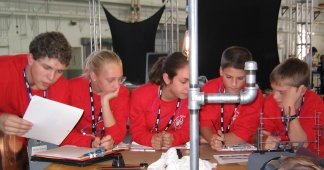 |
|
Zachary Hopkins, Samantha Bates, Elizabeth Monier, Ryan Lee, and Austin Minor (from left to right) of the red team discuss their plans for designing airfoils.
|
|
Emily Sohn
|
Austin was one of 40 middle school students who participated in the Discovery Channel Young Scientist Challenge in Washington, D.C., last week. Selected from a pool of 7,300 nominated science fair winners, the finalists spent 4 days competing for thousands of dollars in scholarships, dream trips, and other prizes.
On the first day, participants displayed the projects that got them to the finals. Then, in assigned teams of five, they spent 2 days trying to solve six 90-minute challenges. Judges kept track of each student’s problem-solving skills and his or her ability to work as part of a team under time pressure. In celebration of the 100th anniversary of the first flight by the Wright brothers, all of this year’s challenges had a flight-related theme.
Wing design
Austin and the red team were working on their first challenge of the competition, called “The Wright Stuff.” Aerospace engineer Scott Bays stood by, in case anyone had any questions. “This is a replica of an apparatus the Wright brothers used in 1901,” Bays said.
Using steel instead of copper, Wilbur and Orville Wright tested various wing shapes in a wind tunnel to find out which one would lift an airplane as high as possible. Two years later, they made the first powered, sustained, and controlled flight in a heavier-than-air flying machine.
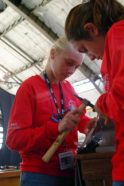 |
|
Samantha Bates and Elizabeth Monier hammer on copper to make sure that the wing has the correct shape.
|
|
Richard Cho
|
As soon as he finished shaping the wing, Austin rushed over to his teammates to put the copper thingy at the end of a wooden wind tunnel. Thirteen-year-old Ryan Lee of Hamilton, Ohio, pedaled a bicycle to power a fan that blew air through the tunnel. The rest of the team measured how far the copper strip moved as the wind blew by it. The more lift, the better. This time, it didn’t move very much.
“The Wright brothers were really smart,” Austin said, as the team scurried back to the drafting table to revise their design.
Afterwards, teammate Elizabeth Monier, a 15-year-old from Boerne, Texas, reflected on how hard it must have been to invent an airplane from scratch. “I’m much more appreciative of how flight happens,” she said. “I didn’t think much about it before.”
Media attention
Throughout the entire competition, a film crew followed the students around with enormous video cameras, bright lights, and broom-sized microphones. The Discovery Channel, which sponsored the event, will broadcast a show about the competition on Dec. 21, 2003.
Traveling to Washington and having cameras shoved into their faces all day long was more challenging for some participants than it was for others. John Reid, a 12-year-old from Redlands, Calif., for one, had, until the competition, never traveled farther than Carson City, Nev., just 400 miles from his home.
“I’ve never been on camera before,” John said on the first day. “I’ve never been on an airplane before. I’ve never been on a train until now.”
Still, all of the students kept up a high level of enthusiasm. They had to. Part of their score depended on how well they could explain what they were doing and their ability to maintain poise on camera.
“We’re looking for science communicators,” said head judge Steve Jacobs, also known as Judge Jake. “Anyone can memorize scientific content. Science is really about thinking, experimenting, predicting, observing, measuring. We designed the challenges to test those skills.”
Explosive challenges
The Wright brothers’ wind tunnel experiment was just one example. Other activities included a challenge called “Rocket Cars,” which called for students to launch a go-cart as far as possible down a 900-foot course. A predetermined amount of carbon dioxide gas powered the car. Teams had to figure out how much air to put in the tires, how much fuel to use at which point on the course, and who to pick as a driver, among other variables.
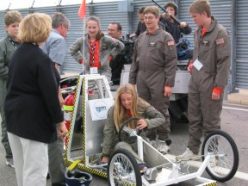 |
|
Taylor Simpkins climbs out of the Rocket Car after her team successfully completed the challenge, with fuel to spare.
|
| Emily Sohn |
Another challenge, called “Super Sonic Tonic,” presented the students with a 5-gallon water drum and a variety of different kinds of alcohol as fuel. Their goal was to get the drum to go as far as possible down a 60-foot track. Each team had 90 minutes to concoct various mixtures, which they put into the drum. A given mixture would be ignited, and the resulting explosion would launch the drum down the track.
Because it involved explosions and loud noises, this challenge was a particular favorite for many participants.
While they worked, the students learned some basic principles of science, including Newton’s laws of motion and the physics of flight. They also learned a lot about the scientific process. “Trial and error,” Ryan said. “That sums up our time here.”
Teamwork helps
Perhaps most important of all, the competitors learned that teamwork could make or break a performance. Going into the last round on the second day, many of the groups had really started to gel. The black team, for instance, had reached a point where they could communicate without even talking.
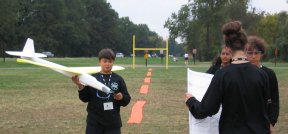 |
|
Bobby Fisher of the black team prepares to launch a glider while his teammates try to figure out what’s going wrong.
|
| Emily Sohn |
Joseph Stunzi, 13, of Watkinsville, Ga., pointed at his head, smiled wide, and nodded vigorously. “Your headache is gone!” said teammate Daniel Steck, 14, from San Antonio, Texas. Joseph laughed and pointed to show that Daniel was right. Pretty soon, all the team members were jumping up and down, and they started practicing a song they had made up together, while waiting for the next challenge to begin.
Forty-five minutes later, the singing had stopped. In fact, the black team was suffering a meltdown.
For their final challenge, “Earth, Wind, and Glider,” the team members had to assemble two rubber band-propelled foam gliders and then throw the planes as far and as straight as they could. For every 25 feet of distance covered, the team earned one point. For every 25 feet the plane went off course, they lost a point. They had to throw in four different directions, one at a time, to deal with all possible wind conditions. They were allowed to make as many throws as they wanted during the 90-minute time slot. Their goal was to reach 50 points.
Halfway through the session, the team had accumulated just 12 points. Gliders were nose-diving into the ground, crash-landing on people’s heads, and curving far off course. “You guys throw now,” said 10-year old Bobby Fisher, from Laguna Niguel, Calif., after a particularly sour landing. “I’m stinking.” The rest of the team was arguing too loudly to hear him.
At that point, judge Bill White stepped in. “Okay, guys, let’s analyze,” he said. “There’s no such thing as a bad mistake in science.”
Bill explained torque, a kind of force that makes things turn. Because the team was twisting the plane’s propeller to the right to wind it up, torque kept pushing the plane to the left. Adjusting the rear rudder fixed that problem.
Suddenly, light bulbs started appearing above the heads of the black team as they pieced together some of the lessons they had learned throughout the week. In the wind tunnel experiment earlier that day, they remembered, they had learned about lift: Rapid airflow over the top of a curved wing makes the plane rise.
Sravya Keremane, 13, from Gainesville, Fla., suggested that they had been throwing the glider upward at too steep an angle. “You guys,” she said, “what if we tilt it down?” As soon as they pointed the nose down toward the ground a little bit, the glider flew much farther.
With a little more practice and a few more adjustments, the team fell into a groove, and the points started piling up. With 10 minutes to go, Daniel launched one of the gliders on a beautiful 168-foot flight that stayed right on course and set a record for the longest flight of the entire competition. The team hit 50 points with 6 minutes to spare. They gave each other high-fives and danced around to celebrate.
Awards time
At the awards ceremony the next day, the sleepy-eyed participants listened to words of advice and encouragement from Apollo 11 astronaut Buzz Aldrin, NASA astronaut Catherine “Cady” Coleman, and Discovery Channel star Dr. Mehmet Oz, among others.
“When I was your age, I had no idea where my interest in science would take me,” said Aldrin in a taped interview. “Just imagine where we’ll be flying 20 years from now. Can you?”
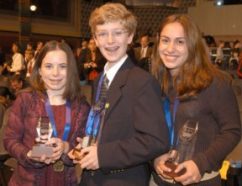 |
|
DCYSC 2003 winners Joseph Stunzi (center) and Elizabeth Monier (right).
|
|
DCYSC
|
Then, Judge Jake announced the winners. Elizabeth Monier took second place and $7,500 in scholarship money. First place and a $15,000 scholarship went to Joseph Stunzi, who leapt from his seat and starting running toward the stage as soon as Judge Jake announced the name of his school. Specialty awards went to a dozen others.
Even those who didn’t win a prize had a blast. Everyone wished they could stay and do more challenges. They also enjoyed getting to know each other. Bonded by a strong passion for science and learning, the students formed friendships fast. Four days flew by, and everyone was sad to go home. On the last night of the competition, they all exchanged e-mail addresses and vowed to keep in touch.
After the cameras are gone and everyone goes back to school, it’s those memories—not the prizes—that will matter most, Joseph said. “I’m going to remember all my friends.”
News Detective: Emily faces a challenge
Going Deeper:







